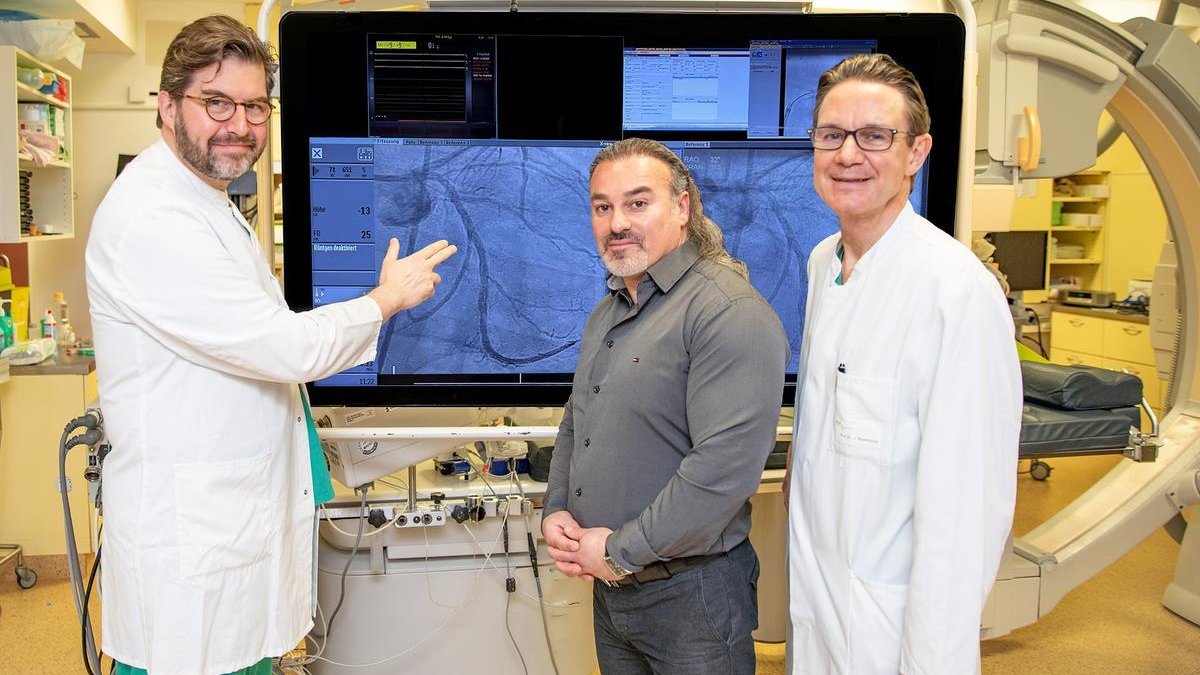Magnesium implants support coronary arteries and keep them open.

Filigree mesh: the new absorbable stent. Copyright: Karin Kaiser / MHH

Very satisfied with the new self-dissolving stent: Dr Napp, patient Cubilay C. and Professor Bauersachs (from left to right). Coyright: Karin Kaiser/MHH
Constricted coronary arteries harbor dangers: Because the heart is not supplied with blood properly, this can lead to pain, cardiac arrhythmia, cardiac insufficiency and sudden cardiac death. One way of eliminating a constriction in a vessel is to implant a stent. This involves the minimally invasive insertion of a small mesh tube into the vessel. Until now, all stents were made of metal and remained in the body, sometimes for decades, depending on the age of the patient. This has various disadvantages, but until now seemed unavoidable. Self-dissolving stents are therefore a groundbreaking innovation. The Department of Cardiology and Angiology at Hannover Medical School (MHH) is at the forefront of this field. A new type of absorbable stent from Biotronik has now been implanted in a patient there. It was the second implantation of its kind worldwide.
Artery regains natural function
A stent restores the blood flow in the originally narrowed coronary artery. It keeps the vessel open and supports the vessel wall. In contrast to metal stents, which remain in the body, bioresorbable stents dissolve by themselves and disappear. Dr. L. Christian Napp sees this as a significant step forward: "Self-dissolving vascular supports ensure that the artery regains its natural function, including the mobility of the vessel wall," explains the Managing Senior Physician and Head of the Cardiac Catheterization Laboratory at the Clinic for Cardiology and Angiology. "This is a great advantage in the event that the arteriosclerosis progresses overall and further interventions on the coronary arteries have to be carried out at a later date." For this reason, self-dissolving stents are particularly suitable for younger patients.
Stent made of magnesium
The new model called Freesolve consists almost exclusively of magnesium, which is already present in the body. The stent dissolves over a period of around twelve months and simultaneously releases a drug that promotes vessel wall healing and prevents re-narrowing. The magnesium stent looks like a short tubular lattice structure. As it has very thin and finely crafted struts, it can be implanted very easily and optimal healing and dissolution can be expected.
Hereditary predisposition
Kubilay C. from Neustadt is the first patient to have this new type of stent implanted at the Clinic for Cardiology and Angiology. The 48-year-old is sporty, does not smoke and lives a healthy life - but has a family history of arteriosclerosis, i.e. hardening of the arteries. "My father and my uncle also had the symptoms," says Kubilay C. He first noticed the disease in December 2022. "I suddenly developed persistent palpitations at work," recalls the pharmaceutical technician. This was followed by examinations at the hospital, at his GP and at a cardiologist in private practice. It turned out that three coronary arteries were narrowed. The cardiologist referred Kubilay C. to the MHH for further treatment. In July 2023, Dr. Napp implanted the first stent, also a self-dissolving predecessor model of Freesolve. "After having good experiences with the predecessor, we opted for Freesolve the second time around," explains Dr. Napp. On February 22 of this year, the time had come. The procedure was minimally invasive and was performed under local anaesthetic. "At the beginning, we checked the stent from the previous year - it was almost unrecognizable as the dissolution was almost complete."
"I'm much fitter"
After a night in hospital, the father was able to return home. Although he still has the third stent implantation ahead of him, he already feels much better than before the procedures. "I notice that I'm much fitter and don't get out of breath so quickly, especially when I'm doing sport. I could train for hours," says Kubilay C. His third stent will also be a Freesolve.
New option for many patients
By implanting stents, Kubilay C. will be spared much more stressful bypass operations. "With the new self-dissolving stents, we have reached a point where metal vascular supports can be at least partially replaced," says Dr. Napp. Clinic Director Professor Dr. Johann Bauersachs agrees: "Self-dissolving stents will be suitable for many patients. That will be the future."
Text: Tina Götting